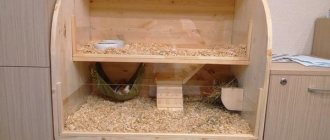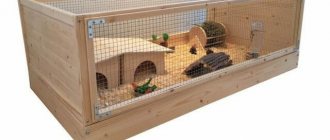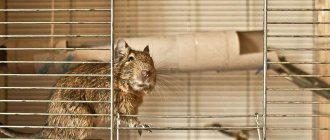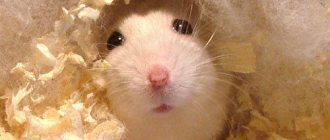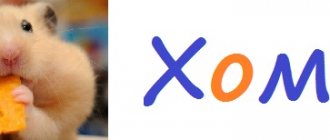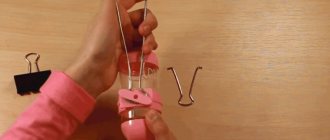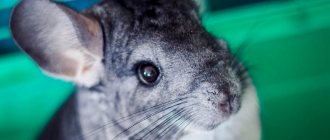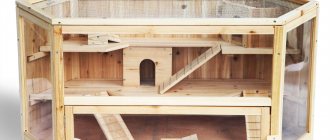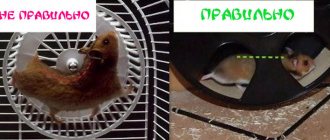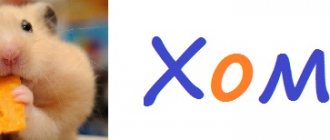A hay box for guinea pigs is a necessary piece of furniture for the animal’s home. All pigs, regardless of their breed and variety (hairless, fluffy, etc.), need to consume a portion of fresh hay every day. But you can’t just spread grass at the bottom of the cage - the animal will stain the food, and its diet should not contain contaminated foods, otherwise such a diet will have a detrimental effect on the pet’s health. To give the pig access to hay, but at the same time keep it clean, rodent owners use a special device - a hay barn.
kak.feedjc.org
The life of a rodent in a cage is not very diverse. Therefore, using devices to entertain your pet will benefit his mood and health. One such device is a guinea pig hammock. It acts as a soft and comfortable shelf for relaxation. But in order to get into it, the pet will have to make some efforts, which will have a good effect on its physical form.
Mirror in a cage
Installing a mirror in a guinea pig's cage is an unmistakable technique. This item ensures that the animal does not get bored. It will become a favorite pastime for the animal. She will spend a lot of time near him, looking at her image with interest. The pet will be confident that he is communicating with another animal, and he will not feel lonely.
It is not necessary to buy a new mirror for the cage. A small old one or a cosmetic bag equipped with a mirror will do.
The only important thing is that there are no chips or sharp elements on it. The best framing options for a mirror are plastic and wood.
The mirror must be fixed well so that the animal does not have the opportunity to move it.
Types of hammocks for guinea pigs
You can please your pet in different ways. A rodent will definitely like a hammock in a cage. This device is sold in the store, or you can make a hammock with your own hands. But first you need to understand what types of hammocks for guinea pigs are.
- rectangular, attached between opposite walls of the cage;
- corner, attached between adjacent walls of the cage;
- tunnel, suspended from the roof of the cage.
The first two types of devices are easy to manufacture, so making a hammock of these shapes with your own hands is easy. It will be more difficult to deal with the house, but the pet’s joy will make up for all the effort and time spent.
Main types of drinkers
There are two types of drinking bowls for rodents: a hanging ball bowl and a regular bowl. The first type is very popular. Its advantages include:
- Dosed supply of liquid;
- sealed design that prevents the cage from getting wet;
- Can be used from any age;
- saving space in the cage;
- performance during transportation of the animal.
You can accustom your guinea pig to drinking water at any age. In addition, sawdust, food debris and other debris from the cage that the pig scatters while moving does not fall into the hanging container.
The ball option has a number of disadvantages:
- The design forces the animal to drink by throwing its head back, which creates additional stress on the spine.
- Neglect of cleaning causes the formation of a greenish coating on the inner walls.
- Price. A ball drinker for a guinea pig costs $3.50 or more, depending on the volume. In addition, it requires periodic replacement.
- The ball makes a loud noise during use.
Due to the specific design and volume, it is difficult to wash such a drinking bowl. For cleaning you will need a long brush and baking soda. After using detergents, the container should be rinsed thoroughly - the rodent’s stomach is sensitive to such substances.
Necessary materials for sewing a hammock
To make a hanging device you will need materials and tools from this list:
- – durable fabric for the base, such as denim, cotton or fleece;
- – interlayer fabric, flannelette, padding polyester or fleece;
- – scissors, needles, threads, pencil, ruler;
- – a carabiner, ribbon or strip of dense fabric for attaching to the bars of the cage;
- – ribbons or buttons to decorate the product.
To make a tunnel-house you will need cardboard.
Making a rectangular hammock
To sew a rectangular hanging shelf, two rectangles are cut out of durable fabric. The optimal length of the rectangle is 40–45 cm, width – 30–35 cm. The fabric for the interlayer is cut out to the same size.
Next, lay the fabric right side up, place a second rectangle on it, wrong side up, and a layer on top of it. All these layers are sewn together, inserting ribbons in the corners for fastening and leaving free space for turning the product right side out.
After stitching, the product is turned inside out. As a decoration, a ribbon or braid is sewn at the seams.
Tapes for loops should be made of durable, non-stretchy material so that the pig does not spring back when climbing or jumping off it.
For attachment to the cage, holes can be made in the corners of the hammock. It is better if the edges of the holes are processed or made with a grommet. In this case, the product will last longer and will be easier to remove for cleaning.
Making a corner hammock
To sew a triangular hammock you need to take the appropriate measurements. Let's imagine that the triangle is inscribed in the corner of the cell. The legs of this triangle will lie on adjacent sides of the cage, and the hypotenuse will be the longest side of the triangle, which is located between the adjacent walls of the cage. The legs should be from 40 to 45 cm, respectively, the hypotenuse from 50 to 55 cm.
Next, you need to cut two triangles from the main fabric and from the interlayer. Sew them together with the outer sides facing each other, inserting ribbons into the corners for fastening and leaving room for turning them inside out. The layer should be adjacent to one of the main fabrics. Then the product is turned inside out so that the interlayer is inside.
In the corners of the triangle, you can use a grommet machine or scissors to make holes for installing fasteners. Strong cords, ribbons or carabiners are inserted into the holes.
A variation of the corner bed is the option with a hanging approach. A rectangle is sewn to the long side of the triangle, which is not attached to the walls of the cage. He is left hanging. It makes it easier for your pet to climb onto his bed. You can also initially cut out the parts, already taking into account the soft ramp.
How to make a hammock house
To make a house you will need:
- durable fabric 130 cm long and at least 30 cm wide;
- pieces of fabric 35 cm long and 25 cm wide;
- sling 200 cm;
- 4 carabiners for fastening;
- bias binding 150 cm long;
- a piece of rectangular plywood 30 cm long;
- thread, needle, centimeter and scissors.
For a piece of fabric 130 cm long, fold the edge with the outer side inward and hem it, leaving one side free. Plywood is inserted into the resulting pocket. You can use thick cardboard instead of plywood. Softer cardboard or padding polyester is wrapped into the other edge of the long sheet. It turns out two pockets. The free edges of the pockets are sewn together. The part of the product with plywood will be the floor of the house.
To strengthen the walls and roof, you need to cut the sling into two equal parts. The edges of the sling are burned to prevent unraveling. Each part is sewn along the walls and ceiling along the edges of the product.
Smaller pieces of fabric are sewn so that they form the walls and ceiling. The end result should be a square shape.
The frame of the house is ready. To make an entrance, you need to make a round hole in the rectangular shape of the fabric. This will be the entrance. It is better to process the edges of the hole or trim it with tape. The fabric itself is sewn from the end of the product. You can simply cover the back wall with fabric, or you can make another entrance there. It is better to make the entrance hole with a diameter of at least 15 centimeters. You can cut a circle by folding the fabric in half twice so that the center of the hole is in the resulting corner. Then cut off this corner at a distance of 7.5 cm from the edge. When you unfold the fabric, you will get a round hole.
Carabiners are sewn to the slings with strong ribbons or laces. The product is ready for use. All that remains is to hang the hammock in the cage at a height convenient for the pig.
There are different variations of hammock houses. They can be made cylindrical or in the form of tents.
Rodents prefer a house more than other types of hammocks because they can hide in it and relax from prying eyes.
Themed cage decoration
It is human nature to decorate his home, to subordinate everything that is in his field of vision to the overall design, so sooner or later the question arises about decorating the home of a furry pet.
You can decorate the hamster cage in accordance with the general style of the room where it will be located.
If this is a children's room, it would be appropriate to stylize the hamster's house as a castle or fortress, and various thematic bridges and ladders will complement the picture.
A cage with a house made of real coconut husk or an inverted flower pot with a sawn-out entrance hole and a reed bridge would look interesting in the kitchen.
By placing the cage in the living room in a high-tech style, you can create a whole spaceport for your pet. A house that smoothly turns into a vertical rocket tunnel and climbing frames in the form of radars, a toilet corner and a feeding trough, veiled as storage rooms, will look very futuristic in certain lighting.
How to train a guinea pig to a hammock
Accustoming to innovation should be done gradually. You should not place a new device in the cage of a pig that has only recently appeared in the house. To do this, the animal must live in the new place for at least two months.
After installing the hammock, the pet may get used to the update for several days, and then begin to be interested in it. The behavior of the pet after the appearance of the innovation needs to be observed. The pet can immediately start jumping into the new bed. If the hammock is located too high, then you need to identify this in time and move it lower.
If the animal does not show interest in the innovation, then you can lure it with a treat. But you shouldn’t get carried away with the food, as the new place can turn into a dining room.
If your pet gets nervous when new objects appear in the cage, then it is better not to make him nervous. You can try a more modest hammock or skip using one altogether.
A hanging lounger should not be frequently moved from place to place. This can only be done after the pet has completely gotten used to it.
Requirements
The main criteria when choosing a cage are its comfort and safety for your pet. In addition, the future home of a furry friend should be comfortable for its owner. The owner needs to select in advance the place where the new home will be located, and also select a product for a certain size, no less than the minimum recommended for a dzhungarik.
The materials from which the cage is made must not only be durable and strong, but also safe. Rodents taste everything they see, so the grill bars they try should not be harmful to the health of the animal.
Choose a cage that is easier to clean. It is more convenient to buy a product with a pallet. Be sure to check that the door closes well.
Djungarians are very curious creatures, prone to escape, and a weak locking device may not withstand its sharp teeth. Try to buy a home with built-in attributes in advance. This will be a more economical option, and in the future you won’t have to think about where and how best to install all the additional devices.
Materials
Pet stores offer several options for hamster cages.
Made of metal rods. A good ventilated home in which the rodent feels quite comfortable. The inconvenience is that the noise the hamster makes can be clearly heard through the bars, and dirt always forms around. Filler and debris easily penetrate through the bars. The grill itself should be made of high-quality solid metal.
Do not take products made of copper or aluminum - the animal gnaws everything, so it will quickly render such rods unusable.
Plastic or glass aquarium. In such a closed home, the noise level is significantly reduced, and there is almost no garbage. In addition, this is the safest option for a home where there are cats - it is unlikely that a predator will get to the rodent, which is kept in an aquarium under a breathable mesh. However, the hamster himself will be uncomfortable in such a home, since it does not allow air to pass through well.
The inconvenience for the owner is that the aquarium is difficult to clean.
Lattice cage with plastic tray. This is the most preferred option. This cage is easy to clean. If the home is two-level, and the “floor” of the second floor is made in the form of a lattice, then check whether the pet is injured by getting its paws or abdomen stuck between the bars. If the risk of injury is high, cover the second level with cardboard.
It is recommended to buy cages in which the second floor is made of plastic and reinforced with high quality. Try to avoid wooden elements in the cage, as wood absorbs unpleasant odors and also becomes a favorite material for grinding down the rodent's incisors.
Designs and sizes
The length of the cage for one dwarf hamster should be at least 50 cm. This is even longer than for a Syrian hamster. And although the Syrian is larger in size than the Djungarian, the miniature pet still has to run a greater distance per day, so it needs a more spacious cage. If the cage is purchased without additional equipment, then do not forget that the area will be reduced due to the established mandatory attributes.
Another important point when choosing a cage is the gap between the rods. It should be no more than 10 mm.
Give preference to a cage with horizontal bars - rodents like this shape more, and it is much easier to attach additional devices to a horizontal grid for a comfortable life for a rodent.
If the distance between the rods is greater, the hamster will definitely try to escape. And even if the cage contains a fairly well-fed individual, this factor does not deprive it of its plasticity.
If you purchase a very spacious cage, then do not forget that cleaning the hamster is done quite often, and the large dimensions of the cage will significantly complicate this process.
However, if the owner keeps several hamsters at once and plans to breed them, then it is better to opt for a large cage. It is worth mentioning separately about the day of the dwelling. It can be with a retractable mechanism or high. A retractable bottom is much more convenient in terms of cleaning, but a cage with a high bottom is suitable for breeders, since the high sides will prevent curious little hamsters from falling out of the cage.
Tips for use
The installation height of the soft shelf is a very important factor. It should be comfortable for the pig to climb into it. And in the event of a fall, the animal should not be injured. Therefore, it is recommended to hang the device at a height of 6 cm to 15 cm from the bottom of the cage.
The dimensions of the product should allow the pet to rest freely on it.
The fabric of the product must be durable. Choose fleece or denim.
The hammock will last longer if there are no threads sticking out of the seams. The pig can chew on these threads, and the product can unravel.
How to install a drinker correctly
Before installation, you should check the quality of the ball drinker. To do this, hang it with its spout outward and place a sheet of paper down. Within several hours there should be no traces of wetness left on the paper. But a few drops are allowed. If there is no moisture, you need to try pushing the ball with your finger. Sometimes the product does not allow water to pass through because it is defective or the lid is tightly screwed on.
A serviceable structure is attached from the outside, with the nose inward. Usually they come with a special wire or fastener for this purpose. But if not, then you can use any wire or elastic band. It should be hung in such a way that the ball is located no higher than 5–6 cm from the floor, so that the animal does not have to throw its head back high.
How to make a do-it-yourself kennel for guinea pigs
All pigs, regardless of the type, need a daily portion of fresh hay: short-haired Selfies, long-haired Peruvian piglets and hairless Baldwin guinea pigs, and all other breeds. If you simply put grass on the floor of the cage, your pet will scatter it and get it dirty, and animals are contraindicated from eating dirty foods. Therefore, every pig breeder sooner or later asks the question: how to make a hay barn for a guinea pig? The answer to this question and useful information about hay can be found in this article.
Before talking about senniks, you should find out what they are needed for. The answer is obvious - hay barns are needed to store hay. Any experienced pig breeder knows about the importance of this product and its benefits for guinea pigs. For those who are just starting their journey in this area, it will be useful to know why a pig needs hay, where to get it and how to choose it.
Why does a pig need hay?
Hay is the most important product in a guinea pig's diet and the main source of fiber. The health of your pet, the condition of its teeth and normal digestion directly depend on hay. It should always be freely available to the animal and kept in stock by the owner.
Where can I get hay?
Hay for guinea pigs can be purchased at a pet store, asked from livestock breeders (at a stable or barn), ordered online, or prepared yourself.
It is necessary to collect grass in places far from highways, industrial zones and livestock walking.
After collection, the hay must be thoroughly dried in a well-ventilated area, constantly turning over. It is better to store the product in linen bags.
What should the hay be like?
- fresh;
- completely dried, without mold;
- free from dust and small particles;
- with long stems;
- composition – forbs (timothy, alfalfa, etc.);
- Green colour;
- smell - fragrant.
Let's move on to choosing a drinking bowl for a rodent
If you have several hamsters, you should decide on the required volume of the drinking bowl. If your pet is alone, then the smallest sippy cup will do. When there are several of them, it is better to choose the medium size. It is recommended to ask the seller to fill the container with water and wipe it. In this way, it is possible to determine the presence of leaks and the unimpeded supply of water.
Pet stores are filled with drinking bowls of various colors, so you can find a product that matches the color of your pet’s cage. Of course, this does not matter to the animal; the main thing is the presence of clean water in the drinking bowl.
DIY sennik
Hay can be placed in a cage in a bale, but this is not aesthetically pleasing and is dangerous, since the pigs will scatter the grass and stain it. It is more practical to place the hay in a special feeder, which will not allow the animals to scatter the contents. Rodent cages are usually equipped with a container for hay. Ready-made hay can be easily found in pet stores.
Many breeders prefer to make hay barns on their own, especially since there is a lot of scope for imagination here.
You can fill any container, box, soft toy, or even a sock with hay. Don't immediately throw away egg trays and toilet paper tubes. By filling them with hay and offering them to your pet, you can make the rodent happy and keep him occupied for several hours.
A simple haybox made from plastic containers
To make a feeder, you will need a disposable plastic container or any plastic container you have at hand, and paper clips (2 or more). The container is filled with hay and attached to the bars of the cage using clothespins. The convenient sennik is ready!
All that remains is to regularly fill it with food. If piglets show interest in paper clips, it is better to hang the clothespins higher so that the pigs do not get hurt.
How to sew a hay bag
- Two identical pieces of fabric (20x30 cm) are folded with the right sides facing each other.
- Next, you need to draw two round windows in the center at a certain distance from each other.
- Windows are cut out on one of the flaps, and the edges of the windows are finished with stitching.
- The product is sewn on three sides, the top remains unsewn.
- The edges of the top must be folded and stitched, after which the product is turned inside out (it turns out to be a bag).
- Then you need to sew 4 ties, 2 on each side of each edge (you get a handbag with handles).
- The bag is stuffed with hay and hung in a cage.
Sennik out of the box
You can build a feeder from a shoebox or small household appliances; it is important that it fits the size of the cage. A lid and one side wall are not needed. The side can be cut off, leaving 5 mm from each edge. Holes are made on two narrow side walls (4 on each side). The sennik is attached to the bars of the cage using fishing line or wire, which is threaded through these holes. The container is filled with hay and the hay barn is ready.
Wooden canopy
For production you will need:
- boards or furniture board;
- drill with grinding attachment;
- jigsaw;
- metal grill;
- hammer;
- furniture dowels (6 mm).
- The boards are sawn into pieces: 2 sides 10x13cm; bottom 10X14cm; back wall 18X11 cm.
- Recesses for the grate are cut in the side walls (the width coincides with the width of the found grate).
- The upper part of the backdrop can be cut in a semicircle (optional).
- Next, the holes are marked at the joints, after which the holes are drilled with a five-millimeter drill.
- The dowels are driven into the holes in the sides with a hammer, and the back and side walls are connected.
- Then the dowels are inserted into the lower part, and the structure is assembled.
- Next, the product must be sanded and the corners smoothed.
- The grille is inserted into the grooves.
- Holes are drilled in the back for attaching to the cage, the hay box is filled with hay and hung.
How to make your own kennel for a guinea pig
Pigs of all types need portions of hay in their daily diet. The haybox for guinea pigs is an important part of the animal’s home. The need for it is also due to the fact that simply laid out dry grass will be scattered around the cage and soiled by the animal, and contaminated products should not be allowed into the food of guinea pigs.
This article will help anyone who wants to understand how to use dry grass feeders to keep their pet healthy and happy.
Before making a hay barn for a guinea pig, you should understand what grass is needed and why.
The hay fields are filled with dry grass, which such a pet needs. It has a beneficial effect on the health and functions of the body. It is important that hay is present in your pet’s diet.
Benefits of hay for pigs
This is one of the main parts of the animal’s diet, as it is a source of fiber. Hay directly affects the health, condition of teeth and digestion of the pig. It is important to monitor the presence of this ingredient when feeding your pet. It’s especially good that you can make a hay barn for guinea pigs with your own hands.
Places to get hay
First of all, you can simply buy dried grass at a pet store, exchange or ask people raising livestock and purchase it online, or prepare it yourself, which will save some money each time you change food. To collect herbs yourself, you should choose remote places away from roads, industrial areas and livestock walking.
You need to dry the herbs in a well-ventilated room, turning them over regularly.
Hay qualities
Only good dried grass should be added to the hay box for guinea pigs so that it is easier for your pet to digest.
Factors that affect hay quality:
- Freshness;
- dryness;
- absence of dust and other particles, as well as mold;
- the presence of long stems;
- composition of several herbs;
- nice smell;
- green color.
Additional accessories
There are certain products for guinea pigs that are aimed at diversifying the animals' lives. These include various kinds of toys, comfortable loungers or hammocks.
Toys are not just for kids!
Guinea pigs are playful animals. Pet stores offer a large number of balls and coils that make ringing sounds when rolled.
You should choose toys made from natural materials, because rodents love to taste everything.
Tunnels
An active animal needs certain sports activities. Guinea pigs have a special affinity for tunnels: they are made of fabric or plastic, and the rodent will actively move in them. You can connect several parts, thereby constructing a labyrinth. A curious animal will be happy to explore it. You can make a tunnel yourself.
DIY sennik
You can place hay in a heap in a cage, however, this will not bring the desired result and may even cause harm, as the pigs will scatter and stain the grass. Under no circumstances should you include contaminated foods in your diet; this will harm your pet.
In order for dry herbs to bring only benefits, it is better to place them in a special container for this. New cages in pet stores are already equipped with them. It is also possible to buy them separately. But many breeders often make them themselves.
You can fill any container with hay, even socks or plush toys. From egg trays and toilet paper tubes, it is possible to make a one-time use toy. By offering your pet such an item, you will please him and keep him occupied for several hours.
From a plastic container
To make a feeder, take any plastic container and paper clips. The container is filled with hay and attached to the bars in the pet's cage using clothespins. Add food regularly and make sure your pigs don't get hurt by paper clips.
From a sewn handbag
- You will need two identical pieces of fabric (20X20 cm), which are folded right sides together.
- Two circles are drawn in the center at a short distance, which should be cut out to form windows.
- Circles have appeared, walk along their outskirts with a line.
- Sew the bag on three sides and tuck the top edges.
- Pull the inside out and knit 4 threads to create handles for the bag.
- Fill the bag with dry grass and place it in the cage.
From the box
A guinea pig canopy can be made from any box, the main thing is to match the size of the cage. Feel free to remove the top and one side part, which, if cut, should be left 5 mm at the edges. Make 4 holes on two opposite walls. The container is filled with hay and attached through it to the cage bars.
Made of wood
You can also make a feeder from boards or other materials of the same origin. This sennik is similar in shape to the previous ones, but the range of options for actions differs. You can make a sennik from this material in any way you like; freedom for creativity is allowed in this matter. You can build a separate container for hay or a common feeder for all food.
Important. Before installation, the resulting structure should be processed and sanded so that the pets are not harmed.
From socks
Such a hay box will be more likely to be a toy for an animal than a full-fledged feeder, but it will still be useful. To make a hay box for a guinea pig, you will need a couple of unnecessary socks, which are stuffed with dried grass and then sewn up. Such a toy will be very interesting to the pig and will captivate it until it breaks. This spectacle looks funny, so you can please both the pet and the owner.
Conclusion
You can make a hay box for guinea pigs with your own hands. This is an important component of this animal’s housing, because hay plays a big role in the diet, affecting many functions of the body. Those who want to purchase or already have such a pet must figure out how to arrange its life in the best possible way, taking care of its health. We hope that the article was useful and you were able to learn something new.
Choosing hay and hay for guinea pigs
join the discussion
Share with your friends
Guinea pigs are fairly easy-to-care pets. The owners of these cute rodents know that in addition to granulated food, the animal’s diet must include hay. It would seem, what is the problem? After all, in the warm season there is a lot of grass on lawns and lawns. But not every plant is suitable for drying and subsequent consumption by guinea pigs. The article will talk about how to choose and prepare hay correctly, as well as how to make a hay barn for guinea pigs with your own hands.
The benefits of hay
It is very important for guinea pigs to receive dry grass every day. For animals it is a source of plant fiber. In addition, pigs wear down their teeth on the hard stems.
How many times a day and in what quantity to consume dried grass, the pet decides for himself. It depends on his well-being and needs.
Therefore, a small amount of hay should always be in the cage so that the pig, when it feels the need, can come up and eat the amount of grass that it needs.
It is for these purposes that the guinea pig house needs to be equipped with a hay barn.
Water parameters
To keep your guinea pig healthy, you need to ensure proper fluid status:
Temperature
The water should be at room temperature; using cold or ice water can cause diseases such as pneumonia.
Quality
The water must be filtered; using tap water is not advisable.
Replacement
Frequent replacement of water in the drinking bowl is necessary, from 1 to 3 times a day, in order to avoid the development of bacteria in stagnant water and their entry into the rodent’s body.
Grass collection
If it is winter and there is no way to find fresh plants, ready-dried hay for pets can be purchased at pet stores or ordered online. It contains guinea pig-safe plants and is fully prepared for pet consumption.
Well, if summer is in full swing, you can collect the grass yourself, while adhering to the following rules.
- The plants that you will harvest should be located away from large cities, highways and highways.
- You should not collect weed near industrial enterprises, or in areas where livestock graze.
- Only healthy-looking plants with a bright green color should be selected. Stems and leaves should not be affected by parasites or diseases.
- Grass that has already dried out is not suitable for harvesting.
- It is advisable that the harvest include alfalfa and timothy. These herbs are rich in beneficial microelements and have a positive effect on the digestive system of rodents.
Plants that can harm guinea pigs:
After collecting, the grass should be laid out to dry in a dry room. Under it you should lay a cloth or a sheet of white Whatman paper. You can also line the drying area with several sheets of plain white paper. It is not advisable to use newspapers for backing. Ink comes off very easily from printed pages and can stick to blades of grass . Harvested hay should not be exposed to direct sunlight.
Periodically, the grass should be stirred and turned over a little so that the stems dry better and more evenly.
Drying continues until all the stems become dull and brittle. After this, the hay must be transferred to a fabric bag. This will help prevent possible mold formation and growth.
Selecting quality food
When purchasing food at a pet store, you should understand which hay is best for your guinea pig and what parameters you need to pay attention to:
- The hay should have a characteristic aroma for this type of grass. The presence of the smell of mold and synthetic substances indicates a violation of storage conditions.
- The hay should not be dusty.
- Hay should not contain foreign impurities, hay dust, insect pests and large stems with sharp edges.
- Hay from plantain leaves should not crumble when touched and turn into powder. This happens when the shelf life of the feed exceeds 7 months.
- The hay should not be wet. With high humidity, pathogenic mold fungi quickly develop in it, which causes poisoning in guinea pigs. Hay with signs of rotting is also unsuitable.
- The color of the hay should match the color of the grass. In most cases, the natural tone is green. Brown, yellow or black stems indicate exceeding the shelf life and loss of quality characteristics of the feed.
Owners who decide to make hay for their pets themselves must adhere to the following rules:
- plants for drying should be collected in areas remote from large cities, away from highways and industrial enterprises;
- you cannot collect grass from the pasture;
- herbaceous parts of plants should not be affected by pests and diseases;
- The stems and leaves of the plants should be green and not dried out.
When making hay for guinea pigs, the following herbs should not be used:
- celandine;
- spurge;
- hawthorn;
- lily of the valley;
- plants of the nightshade family;
- horsetail;
- hemlock.
The collected grass must be laid out on cloth or white sheets of paper in a ventilated, dark room.
Important! You should not use newspaper for drying, the printing ink of which can get on the plants and subsequently cause allergies or poisoning in the guinea pig.
To ensure even drying, plants should be carefully turned over. After the color of the stems has faded and they have become brittle, the hay is folded in portions into fabric bags, which are stored in a dry room.
Important! For guinea pigs with long hair, the hay should be cut, and before serving, the blades of grass folded together should be tied in the middle. This will make it easier to care for the coat and help avoid difficulties when combing.
How to make a sennik?
You can build a hay holder yourself. The materials for its manufacture can be very diverse. If you rummage around in the mezzanine or in the pantry, you will probably find something there from which you can make a feeder for your rodent. Below we will present several options for a hay barn for a guinea pig's cage or house.
- Dry herb holder made from a cardboard box. Any undamaged and undeformed cardboard container will do. The choice of size depends on the dimensions of the pet's house. Cut off the top and one of the sides, leaving 5-7 millimeters of border along the bottom edge. Make symmetrical holes on the sides of the box. Then you will need to insert a flexible wire into them and secure the hay bar to the wall of the pig's house or cage.
- A holder for dried grass can be made from plywood or boards. Take the pieces of the required size and glue them together in the shape of a box with three sides. Such a hay can be placed on the bottom of the cage, if space allows. Or, as in the previous example, attach it to the wall of the house.
- Fabric hay. Find two pieces of durable cotton fabric measuring approximately 20 x 20 cm. Fold them right sides together. In the middle, draw and cut out two circles of small diameter. These holes will later serve as windows for the pigs to supply dry grass. Sew the pieces of material along three sides, leaving the top edges free. You will get a small bag with two holes on the sides. Sew handles to it and hang it from the bars of the cage.
What can you use to make a hay feeder?
Dry grass can be placed in any container. You can even use old socks, whatever you have on hand. The main thing is that the pet is comfortable, the feeder does not take up much space. First, imagine the design and shape, then begin manufacturing from the selected material.
Plastic bottle
To work, you will need an unnecessary 1 liter bottle, wire and a sharp knife. The container must first be washed and dried so that the grass is not saturated with foreign odors.
Sequencing:
- In one of the sides, cut a hole in the form of a square or rectangle, large enough to remove the food.
- To thread the wire, you need to make through holes from the bottom.
- On the other hand, the bottle is tied around the cap.
- Secure the bottle to the bars of the cage.
Tree
A wooden structure can be of any size and shape - it is your ability to work with the material and your imagination. The advantage of wood is that it is natural and does not contain harmful impurities. To work you will need:
- two round flat disks with a diameter of 10 cm and a thickness of 1.5 cm;
- wooden rods 25 cm long, 1 cm in diameter - 4 pcs.;
- wood glue;
- knife;
- twine or wire;
- sandpaper;
- jigsaw
Disks can be cut from a small log; any strong sticks of the required size will be suitable as rods.
- In each of the disks, carefully use a knife to make non-through holes according to the size and number of rods.
- The notches should be at an equal distance from each other.
- Coat with any wood glue.
- Place the rods in one disk, and attach the second round piece on top in the same way.
- The result will be a cylinder shape with longitudinal holes into which the food is placed.
- Using one of the rods, the structure is tied with wire to the wall of the cage. Can be installed indoors or outdoors.
Cardboard box
One handy cardboard item is a reel of leftover paper towels. There is no need to invent anything here, there are two holes on the sides. You can attach it by stretching a string inside and pressing it horizontally against the wall of the house. For the pig, cut a rectangle on the other side. If there is a rectangular box like a brick, measuring approximately 20x10x5 cm (length, width, height), then with the help of a few simple manipulations it is transformed into a convenient feeder.
Items needed for work:
- twine;
- stationery knife;
- glue for cardboard.
Manufacturing instructions:
- Glue the sides to secure them well.
- On one side, make two round holes for fasteners.
- Place the long side of the box horizontally.
- Cut the top part of the brick along its entire length and do not tear it off. This will be a hole for storing hay with a closing top.
- Use a knife to make several holes on the side of the animal through which it is convenient to get the hay.
The design is simple, but it will not last long, since the cardboard absorbs moisture and quickly becomes unusable.
Textile
Any thick fabric will do for a bag feeder. The dimensions of the two flaps are 20×20 plus a 1 cm seam allowance. It’s good if you have a sewing machine in the house, the work will turn out neat. You can also make embroidery or applique for your pet. Twine or thick strong thread is suitable as fastening.
How to make your own kennel for a guinea pig
A hay box for guinea pigs is a necessary piece of furniture for the animal’s home. All pigs, regardless of their breed and variety (hairless, fluffy, etc.), need to consume a portion of fresh hay every day. But you can’t just spread grass at the bottom of the cage - the animal will stain the food, and its diet should not contain contaminated foods, otherwise such a diet will have a detrimental effect on the pet’s health. To give the pig access to hay, but at the same time keep it clean, rodent owners use a special device - a hay barn.
The purpose of the hay barns, as their name suggests, is to store dried grass. This product is good for the health of the animal and plays an important role in maintaining the normal functioning of the pig's body. That is why hay must be included in your pet’s daily diet.
Why does a pig need hay?
This is one of the key components of the rodent's menu. Herbs cannot be excluded from your pet’s diet; for him they are the main source of fiber. The functioning of the digestive system, the condition of the pet's teeth and its overall health are inextricably linked with the consumption of hay. The pig should always have this product freely available and in sufficient quantity. Therefore, it is advisable to store it, as they say, with a reserve.
Where can I get hay?
Hay for your pet can be purchased in various ways:
- buy in a store with goods for animals;
- ask from farmers or livestock breeders, in a cowshed or stable;
- order online.
But if possible, you can prepare hay for a small pet on your own. Only places located away from areas such as:
- highways and roads;
- enterprises and industrial zones;
- pastures and livestock walks.
The collected grass is thoroughly dried. To do this, lay it out in a well-ventilated room. During the drying process, the hay must be turned regularly. When the product is ready, it is placed in linen bags for storage.
What should the hay be like?
There are special requirements for the quality of hay - it must be:
- fresh;
- well dried;
- fragrant smelling;
- Green colour;
- long-stemmed;
- consisting of various herbs (alfalfa, timothy and others);
- not moldy;
- dust-free and free of other small particles.
DIY sennik
Hay placed in a cage simply in a pile will not benefit the health of the pet - the pigs will eat the product contaminated by themselves. To avoid this, it is worth equipping the animal’s home with a hay barn - a special feeder where grass is placed. This device provides the pig with unhindered access to food, but at the same time eliminates the possibility of it being scattered throughout the house.
Pet stores usually sell cages already equipped with a hay box. There you can also purchase a container for hay separately from the cage. There is an alternative option - you can make a hay barn for guinea pigs with your own hands. This does not require material costs and provides complete freedom of creativity.
You can use boxes and other containers as a hay box; even socks and plush toys will do. And from egg trays, as well as paper napkin and toilet paper rolls, you can make a disposable toy haymaker. By placing grass inside these items and giving them to the pet, the owner will delight the pet with new fun, which also contains a nutritional surprise.
A simple haybox made from plastic containers
You can turn a simple plastic container box into a hay feeder. However, any other plastic container will do. The container is secured to the bars of the cage using paper clips. The fastenings should be made higher - this will protect the animals from getting wounds and damage. That's all - the hay barn for the pig is ready. All that remains is to fill it with grass. And of course, we must not forget to add fresh product to this homemade feeder in time.
How to sew a hay bag
To make a hay bag you need:
- Take two pieces of fabric measuring 20x30 cm each.
- Place them right side together.
- Draw two circles on one side in the center (there should be a gap between them).
- Cut out the drawn circles on one piece of fabric to create two windows.
- Finish the edges of the cut out windows with a stitch.
- Sew pieces of fabric along the bottom and side edges, leaving the top edges unsewn.
- Fold in the top edges of the product and finish (stitch) them.
- Turn the product inside out.
- Sew 4 ropes to the upper edges of the resulting bag - two on one and two on the other. Using these ties, the bag will be attached to the bars of the cage.
All is ready. All that remains is to fill the hay bag with food and place the feeder in the pig’s house.
Sennik out of the box
You can make a hay box for a guinea pig from a shoe box or cardboard packaging from small household appliances. Any cardboard boxes will do, the main thing is that they match the dimensions of the animal’s house - the feeder should not fill the entire space of the home. The top and one long side are removed. When removing the side, you should leave 5 mm of cardboard around the edges. 4 holes are pierced on both narrow sides. A wire or fishing line is pulled through them, through which the hay is attached to the bars of the cage. The feeder is ready - you just need to place the product in it.
Necessary purchases for meeting a hamster
Cell selection
A comfortable house will help your pet go through the adaptation period easily and calmly. Today, a wide selection of cages are available in pet stores: from budget options to luxurious “palaces”. They buy a home taking into account their financial capabilities.
Which cage is better to choose?
A hamster's favorite pastime is gnawing on all available objects. It is impossible to house animals in wooden, cardboard and plastic dwellings. Otherwise, he will eat “ingredients” that are dangerous to the body.

